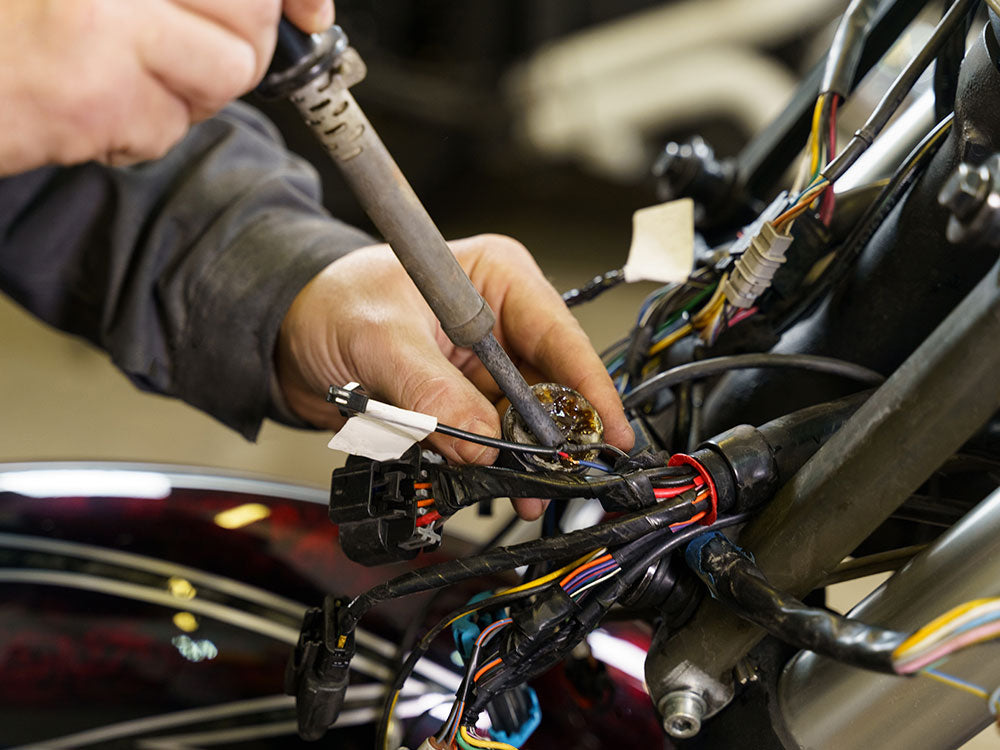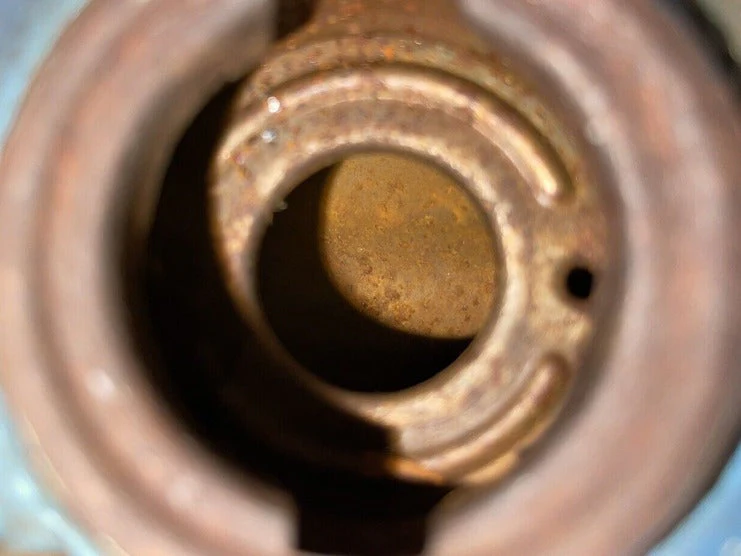Almost all motorcyclists add electrical accessories to their bikes at some point in their lives, especially if they plan to make a long-distance trip. Since these accessories make riding safer, more comfortable, and more enjoyable, most touring motorcycles have them as standard features. Much like saddlebags, crash bars, windshields, and fairings, aftermarket electrical accessories can transform a standard bike or a cruiser into a capable tourer.
An electrical add-on is any part that does not come as a factory-made feature and connects to the electrical system, such as strobing brake lights, phone charging port, stereo system, speakers, auxiliary lights, GPS, heated vest, and grips.
However, the major drawback of aftermarket electrical accessories is that they might draw too much power from your motorcycle’s charging system. Since your bike’s electrical system is already powering the headlight, instrument cluster, ignition system, EFI fuel pump, brake lights, and turn signals, adding these accessories may drain the battery faster.
Table of Content
1. Determine Your Bike’s Power Output
Before you add custom accessories to your bike’s electrical system, you first need to determine the resting or idle voltage of the battery and understand the relationship between voltage, current, and power.
1.1 Basic Formula to Calculate Power Output
Most motorcycles operate with a 12-volt battery capable of 7 or 9 amperes. If you check the voltage of a fully-charged battery with a multimeter, you may get a slightly higher reading of 12.6 volts when idle. At 3,000 rpm, this reading can go up to 15 volts. With this information, you can calculate your bike’s resting and running power output.
Here is the formula:
| Current (Ampere) x Voltage (Volt) = Power (Watt) |
To calculate power (watts) generated from the current (amperes), multiply it by the number of volts, which in this case, are 12 volts.
If your motorcycle’s charging system is rated 9 amperes, then the idle wattage would be:
9A x 12V = 108W
*add your bike’s specific number for an accurate number
Ampere Hour
Ampere hour is a unit of measurement that calculates how long a battery current is drawn from it at a steady rate. A standard 12 Ah battery can generate 1.2 amperes for 10 hours or about 12 amperes per hour before it loses charge. Knowing the ampere-hour can help you avoid drawing too much power from the alternator.
1.2 The Motorcycle’s Charging System
The parts of the charging system that generate power and allow you to add electrical accessories include the following:
Regulator
Also known as the rectifier, a regulator converts the alternating current (AC) from the alternator into the direct current (DC), which charges the battery and powers other electrical components. It is worth mentioning that the rectifier does not feed into the custom electrical accessories.
Battery
A motorcycle battery supplies power to the electrical components when the alternator’s output is low. This often happens when riding in stop and go traffic since being at rest and low rpms cause the alternator to generate less current.
Adding high-powered electrical gadgets like heated grips, stereo systems, and high beam lights can cause the battery voltage to drop at a level too low to start the bike.
Alternator
An alternator converts the chemical energy from the fuel into electrical energy, charges the motorcycle battery and feeds power to other electrical parts. For example, the horn, headlight, and fuel gauge draw power from the alternator. If the custom electrical add-ons draw more power and exceed the alternator’s power output, the battery will make up for the power disparity as explained above.
1.3 Total Power Output and Engine RPM
Once you determine the idle power output, learn the wattage at different engine rpms since power outputs tend to increase at higher rpms. You can check your bike’s specifications by reading the owner's manual. You could also visit a dealership or seek professional help to calculate your bike’s power outputs at different rpms.
Once you have determined the power output range, you can calculate the extra wattage that can be used to power electrical accessories. Here is a quick example:
- Idle Power Output: 9A x 12V = 108W
- Power Output at 5000 rpm: 30A x 12V = 360W
Note: For some bikes, the voltage will also increase with rpm due to their charging systems. Make sure you consider this factor when calculating power output at a higher rpm.
Subtract the Excess Power Available: 360W - 108W = 252W
In this example, you can mount accessories that require less than 252 watts to ensure a comfortable riding experience. Remember, this calculation will always be an estimate. You should always leave 20% of the extra power available to create a reliable buffer. In this case, it would be the following:
20% Power Buffer: (20 ÷ 100) x 252W = 50.4W
252W - 50.4W = 201.6W
Even if you have 252 watts at your disposal, only install accessories that draw up to 201 watts and save the remaining 50 watts to keep the battery from overloading.
1.4 Average Power Draw of Built-In & Aftermarket Electrical Accessories
Knowing the power requirements for factory and aftermarket accessories can help you calculate the amount of power used and available. To avoid exceeding the available power output, take into account the power output of the following electrical components.
| Power Draw of Motorcycle’s Electrical Components | |
|---|---|
| Ignition | 5A x 12V = 60W |
| Fuel Pump (only in fuel injected engines) | 5-8A x 12V = 60-96W |
| Brake Light | 0.83A x 12V = 10W |
| LED Turn Signals | 0.25 - 0.45A x 12V = 3-5W |
| Gauges | 0.83A x 12V = 10W |
| Cooling Fan | 7A x 12V = 84W |
| Power Draw of Motorcycle’s Electrical Accessories | |
|---|---|
| Heated Gear | Vest - 6A x12V = 72W Pants - 2.5A x 12V = 30W Liner/Jacket - 7A x 12V = 84W |
| Auxiliary Lights | 4A x 12V= 48 W |
| Heated Grips (per pair) | 4A x12V = 48W |
| Average Stereo System | 1.7-2.5A x 12V = 20-30W |
| GPS | 0.5A x 12V = 6W |
| Handlebar Mobile Phone Charger | 1.1A x 12V = 13.2W |
| Fog Lights (2-3) | 1 light - 0.75A x 12V = 9W 2 lights - 2(0.7A x 12V) = 18W 3 lights - 3(0.7A x 12V) = 27W |
Having all of these accessories active at the same time will require an additional 318 watts. With only 201 watts available, you can either run a single high-power or a couple of low-power accessories at a time. For summer riding, you should prioritize the lights, GPS, and sound system. For winter riding, you should prioritize the heated gear, grips, auxiliary lights, and fog lights.
2. Tips to Increase Motorcycle’s Power Output
If you want to have more accessories running at the same time without overloading your battery, you can create a system suited for higher power outputs:
- You should replace the stock lights with LED lights if your motorcycle does not already have them. Compared to factory headlights, LED light bulbs consume less power, so you can use the remaining power to charge your phone, use a GPS, or play a standard sound system.
- If your motorcycle’s low beam does not switch off when you switch on the high beam, you should add a circuit that will switch off the stock headlight to help save power.
- Try to get factory-made accessories from well-known brands instead of cheap aftermarket ones. Most motorcycles feature an extra socket to plug in electrical devices. To be able to add extra accessories, you would need a splitter with at least a single socket. OEM sockets are the best way to safely run every accessory without killing the battery.
- Do not connect the accessories directly into the battery if you want to avoid the following problems:
- Messy cluster of wires
- Short circuits
- Loose terminals
Moreover, if you plug accessories directly into the motorcycle’s battery, they will continue to draw power until you turn them off manually. It is not uncommon for riders to forget to turn off the auxiliary lights. With nothing switching off the lights, you run the risk of a dead battery. Avoid plugging the accessories into the battery or get a relay switch that will supply power to the additional electrical equipment only when the ignition is on. As soon as you turn off the ignition, the relay switch will cut the power supply from the battery. If you want to plug multiple accessories into the battery, you would need a distribution block system since a relay switch can only control a single accessory. A distribution block will help keep all your wiring organized in one place and will switch off all the accessories as soon as the ignition turns off.
- A motorcycle battery provides a consistent power output to the electrical accessories. Do not disconnect the battery when operating your motorcycle.
- Between solid or mechanical relays, you should opt for solid relays. They are pricey but draw less power, increasing your battery’s life and performance.
3. Common Mistakes That Cause Electrical Failures
An electrical failure is a major issue many riders have to deal with when on the road. These electrical malfunctions usually occur due to the following mistakes riders often make:
- Plugging old and used wires with rust build-up.
- Loose connections.
- Using poorly insulated wires with low heat tolerance or attaching wires near the hotter motorcycle parts, such as the engine or exhaust.
- Not cleaning the wires properly. Oxidative elements and moisture on the wires can cause electrical failures.
- Too much tension in the connectors and wires due to poor placement. For example, putting extra wires below the seat or handlebars will cause them to press and rub against each other, causing friction that can damage the wiring.
- Using low-quality connectors
- Not connecting or disconnecting the wires properly, or pulling the wire out of the connector.
- Replacing filament turn signal bulbs with LED bulbs can cause malfunctions. Check with a mechanic or an electrician before you swap the bulbs.
- Using wires that are too long or short can result in them falling out, coming loose, or getting tangled. Make sure you get wiring that is the right size and thickness to ensure an adequate power supply. Relay wiring should be large enough to manage the power output or it could result in a short circuit. Most electrical fires occur due to wires designed for small power outputs and connections being overloaded.
All of these issues can increase the risk of a short circuit. To prevent electrical issues, make sure to use high-quality wires and connectors. Also, consider seeking professional help if you need advice from someone who understands complex electrical systems.
4. Takeaway
Riding a well-equipped motorcycle is a pleasurable experience. Every rider wants to experience maximum comfort when riding a motorcycle on the road. To improve riding comfort, riders can install several aftermarket accessories, with electrical accessories being at the top of the list. Anyone who does not want a boring trip can get a sophisticated sound system, install a GPS tracker for protection from thieves, improve visibility with high-beam auxiliary lights, and stay warm in frigid temperatures by getting heated gear and grips. However, you must be mindful of your motorcycle’s battery before adding and using electrical equipment. Never install accessories that can damage or overload your battery.













Leave a comment
All comments are moderated before being published.
This site is protected by hCaptcha and the hCaptcha Privacy Policy and Terms of Service apply.